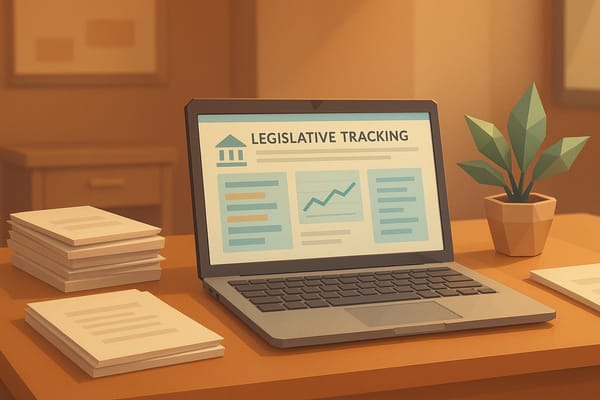Top 6 Ways to Contact Your Representatives Effectively
Learn effective strategies to communicate with your representatives, from emails to social media, to influence policy and advocate for change.

- Write Clear Emails: Personalized, concise emails with a clear ask are impactful. Include your name, address, and personal connection to the issue.
- Call Their Office: Phone calls are tracked by staff and can influence decisions. Be prepared with talking points and stay brief.
- Attend Town Halls: Engage directly with representatives, ask questions, and share your concerns face-to-face.
- Use Social Media: Platforms like Facebook and Twitter can amplify your message. Tag your representatives and include your location.
- Meet in Person: Schedule meetings to discuss issues in-depth. Be well-prepared and follow up afterward.
- Leverage Online Tools: Use platforms like cicada.guide to track legislation, simplify bill summaries, and draft effective messages.
Key takeaway: Your voice matters. Whether through emails, calls, or in-person meetings, you can influence policies and hold your representatives accountable.
Quick Comparison:
| Method | Best For | Key Tips |
|---|---|---|
| Detailed communication | Personalize, keep it concise, and include your address. | |
| Phone Call | Immediate impact | Be clear, concise, and call during office hours. |
| Town Halls | Direct engagement | Prepare questions and share personal stories. |
| Social Media | Public visibility | Tag representatives and engage regularly. |
| Face-to-Face | Building relationships | Schedule in advance, research, and follow up. |
| Online Tools | Tracking and efficiency | Use AI tools to stay informed and draft messages. |
Start with one method and expand your efforts to increase your impact. Ready to take action? Let’s dive deeper into each method.
How To Email Representatives?
1. Write Clear, Direct Emails
Email remains one of the most effective ways to reach representatives, but crafting the right message is crucial. According to research, 88% of congressional staffers say lawmakers are influenced by personalized emails.
Start your email with your full name and address. This confirms you're a constituent, making it easier for staff to verify you're from their district.
Keep your email short and to the point. Messages under 500 words tend to get about 100 more clicks. Here's a simple structure to follow:
- Open with your position and specific request: Be clear about what you want.
- Explain why it matters to you: Share a personal connection to the issue.
- Make one specific ask: Focus on a single request to avoid confusion.
- Provide your contact info: Make it easy for them to follow up.
"The email coming from a real person resulted in 46% more opens and a whopping seven times more clicks than a newsletter-style email. So it seems that policymakers prefer emails and stories from real people, rather than newsletters from organizations." - Jessica Pugel, Research Associate at Pennsylvania State University's Research-to-Policy Collaboration Center
Tips for Writing Effective Emails
| Do | Don’t |
|---|---|
| Write in your own words | Copy form letters |
| Share personal experiences | Attach files |
| Focus on one issue | Email multiple representatives at once |
| Be respectful and timely | Use threatening language |
| Proofread carefully | Write overly long emails |
Even small personal touches can make a big difference. Adding a few original sentences to a form email can increase its impact by 37%. Instead of just opposing a healthcare bill, for example, explain how it would affect your family’s medical costs or access to care.
Subject Lines Matter
Use clear and straightforward subject lines that state your topic and position. Research shows that transparent subject lines generate 50% more engagement than vague or overly dramatic ones.
Timing is also key. Send your email during active legislative debates for maximum impact. Coordinated efforts from others in your district can amplify your message, showing widespread concern about an issue while keeping each email unique.
For help tracking legislation and timing your messages, check out platforms like cicada.guide. Up next: how a well-timed phone call can make an even bigger difference.
2. Call Their Office
Picking up the phone and calling your representative's office is one of the most direct ways to have your voice heard. According to Working America, offices keep track of every call to measure how constituents feel about key issues.
Best Times to Call
For the Washington, DC office, aim to call between 9:00 AM and 5:00 PM EST. For your local district office, stick to their regular business hours. Timing matters - calling right before a major vote can make your message even more impactful.
Preparing for Your Call
Before you call, make sure you have the following information ready:
| What You Need | Details to Prepare |
|---|---|
| Bill Information | The bill's name and number |
| Your Details | Your full name and address |
| Talking Points | 2-3 key points to share |
| Your Request | The specific action you’re asking for |
| Relevant Background | Any expertise or personal connection to the issue |
Making an Effective Call
Keep your message short and to the point - staffers handle a high volume of calls daily.
-
Start the Conversation
Introduce yourself: "Hello, my name is [Name], and I’m a constituent from [City, State]. I’d like to speak with Representative [Name]’s office." -
Explain Your Purpose
Ask to speak with the legislative aide covering your topic. If they’re unavailable, share your message with whoever answers. -
Share Your Position
Clearly explain your stance and how it affects you. For example:
"I’m calling about House Bill 123, the Clean Energy Act. As a small business owner in renewable energy, this bill directly impacts my ability to create jobs in our community."
"Elected officials and staffers log every call that comes into the office. They use these numbers to help determine how their constituents are feeling about a particular issue." - Working America
Follow-Up Steps
After your call, follow these steps to leave a lasting impression:
- Ask for a Response: Request the office’s stance on the issue.
- Take Notes: Write down the name of the person you spoke with.
- Send a Thank You: A quick email thanking the staff member can strengthen your connection.
- Stay Updated: Keep track of the issue through official updates.
For urgent concerns, prioritize calling the Washington, DC office, as district offices mainly focus on constituent services.
3. Join Local Town Halls
Town halls give you the chance to voice your concerns directly to your representatives in person. They provide a platform for face-to-face discussions, making them a valuable tool for advocacy.
Finding Town Hall Events
To locate upcoming town halls, check these reliable sources:
| Source | Where to Look | What to Watch For |
|---|---|---|
| Official Channels | Representative's website | Look under "Events" or "Press Releases" |
| Social Media | Facebook, Twitter | Announcements on official accounts |
| Local Resources | Newspapers, Eventbrite | Listings in community calendars |
| Direct Contact | Office phone/email | Ask about their regular schedule |
Your representative's website and social media accounts are often the best places to find announcements. Local newspapers and community platforms are also helpful for event details.
Making an Impact at Town Halls
Before attending, do your homework. Review your representative's voting record and prepare clear, specific questions. Collaborating with others in your community can help sharpen your focus.
At the event:
- Arrive early: Get there at least 30 minutes beforehand to grab a good seat and network with others.
- Use personal stories: Share brief examples to show how policies affect you or your community.
- Stay composed: Keep your tone professional and polite while asking for direct answers.
- Take notes: Record key points and responses if allowed.
Your presence and preparation can make a strong impression, complementing other forms of outreach.
Following Up
After the town hall, keep the momentum going:
- Post highlights on social media using event-specific hashtags.
- Send follow-up questions to your representative's office for clarification or further discussion.
- Connect with other attendees to organize future advocacy efforts.
- Track your representative's actions on the issues raised during the event.
4. Connect Through Social Media
Social media platforms like Facebook and Twitter offer a powerful way to connect with representatives, complementing email and phone outreach. Studies show that even a small number of social media interactions can have an impact comparable to thousands of emails in grabbing congressional attention.
Platform Effectiveness
| Platform | Engagement Rate | Staff Perception | Best Practices |
|---|---|---|---|
| 46% positive | Seen as most representative of constituents | Comment on official posts, share local stories | |
| 16% positive | Useful for reaching media and influencers | Tag official handles, include location | |
| 44% positive | Builds a more personal connection | Engage with community updates |
These stats highlight how social media can amplify traditional outreach efforts.
Crafting Effective Messages
Just 10 comments can be enough to catch the attention of congressional staff. To make your messages count:
- Add your location to your profile and messages to confirm you’re a constituent.
- Keep discussions professional, especially when addressing sensitive topics.
- Engage regularly instead of relying on one-off campaigns.
- Use visuals like photos or graphics to increase visibility.
"Facebook is still king, and Twitter is crown prince", says Brad Fitch, CMF President and CEO.
Strategic Engagement Tips
Facebook is second only to email in importance for congressional offices. Here’s how to make the most of it:
- Monitor Official Pages: Keep track of your representative’s posts. With an average of 23,000 likes on their Facebook pages, there’s plenty of room to engage.
- Join Discussions: Participate in conversations on their posts. A survey found that when multiple constituents comment together, it significantly influences congressional members.
- Stay Consistent: Build ongoing dialogue. Sixty-three percent of congressional staff expect social media engagement from constituents to grow in the next 5–10 years.
Using Social Media Tools
Platforms like Cicada.guide make it easier to contact representatives and track votes. By combining these tools with legislative tracking, you can better time your social media efforts to ensure your voice is heard.
Next up: Learn how face-to-face meetings can take your advocacy to the next level.
5. Meet Face-to-Face
Meeting in person can leave a lasting impression on your representative. Here's how to make the most of it.
Scheduling Your Meeting
Plan ahead to secure a meeting:
- Washington, DC office: Book 2–3 months in advance.
- District office: Book 2–4 weeks in advance.
Check the congressional calendar for "District or State Work Periods", when representatives are more likely to be in your local area. When contacting the scheduler, be sure to include:
- Your status as a constituent.
- Preferred dates and times.
- The topic of discussion and any related legislation.
Preparing for the Meeting
Being well-prepared helps ensure your message is clear and impactful. Face-to-face meetings build on previous outreach efforts (like emails or phone calls) by allowing a more personal connection.
Here’s how to prepare:
- Research: Look into the representative’s committee assignments and recent votes (do this about a week before the meeting).
- Summarize: Create a one-page document outlining your key points (prepare this 2–3 days before the meeting).
- Practice: Rehearse a concise 5-minute presentation (the day before the meeting).
- Follow up: Send a thank-you email right after the meeting.
Making Your Case
Communicate your position clearly and effectively:
- Share real-life examples of how the issue affects your local community.
- Clearly state what action you’re asking for.
- Explain why this issue is personally important to you.
Additional Tips for Success
If you’re meeting with a staff member instead of the representative, treat the conversation with the same level of importance. To leave a strong impression:
- Tailor your discussion to align with the representative’s interests.
- Bring concise, well-organized materials (like your one-pager).
- Offer to be a resource for future questions or information.
- Follow up on any unresolved topics after the meeting.
6. Use Online Advocacy Tools
Online advocacy tools bring a new level of efficiency to citizen engagement and legislative tracking, making it easier to ensure your voice is heard. These tools build on traditional outreach methods by leveraging digital technology to simplify and enhance advocacy efforts.
Understanding AI-Powered Legislative Tools
Platforms like cicada.guide use AI to break down complex legislative language into straightforward, actionable insights. These tools can help you:
- Simplify bill summaries into plain English
- Keep track of legislation that matters to you
- Create effective messages to send to representatives
- Monitor your representative's voting record
Features to Consider
When choosing an online advocacy platform, look for tools that offer these key features:
| Feature | Purpose | Benefit |
|---|---|---|
| Bill Summaries | Simplifies legal jargon | Helps you make informed decisions |
| Representative Tracking | Tracks voting records | Shows alignment with your values |
| Communication Tools | Assists in drafting messages | Improves the quality of your outreach |
| Legislative Feeds | Recommends relevant bills | Keeps you updated on important issues |
These features make it easier to stay informed and take meaningful action.
Making the Most of Digital Platforms
While traditional advocacy methods are still important, digital platforms provide real-time updates and make communication more efficient. Here’s how to maximize their potential:
-
Set Up Personalized Feeds
Many platforms offer three types of feeds:- "For You": Customized recommendations based on your interests
- "Discover": Highlights new legislation in your areas of focus
- "Tracking": Keeps you updated on bills you’re following
-
Use AI-Assisted Communication
AI tools can transform your ideas into clear, professional messages that resonate with lawmakers. -
Track Representative Alignment
Monitor how often your representative's votes align with your values. This insight can guide your future communications and voting decisions.
Best Practices for Digital Advocacy
To make the most of online advocacy tools when contacting your representatives:
- Verify Information: Always cross-check AI-generated summaries with official sources.
- Personalize Messages: Add your own experiences to AI-generated drafts for a personal touch.
- Stay Organized: Use the same platform to track your communication history.
- Follow Up: Keep an eye on bill progress through the platform to stay engaged.
Conclusion
Communicating effectively with your representatives plays a key role in democracy. Using a mix of outreach methods can help you make a stronger impact on policy decisions.
Taking Action Today
Here’s how you can get started:
- Find your representatives on USA.gov.
- Focus your efforts on specific bills or issues.
- Begin with your preferred communication method, whether it’s email, phone calls, or letters, and then broaden your approach.
- Use resources like cicada.guide to track legislation and voting records.
"There isn't a magic combination of words that changes a legislator's mind - it's a slow burn of many personal stories from a variety of people that moves the needle".
Ernesto Falcon reminds us: "Every letter, phone call, or email you send is critical because most people do not contact Congress".
Staying engaged over time strengthens your influence and helps create meaningful change.
Building Long-term Impact
Advocacy isn’t just about one-time actions - it’s about building relationships. Here are some strategies to keep in mind:
- Be a Resource: Share your knowledge and personal insights to help inform policy decisions.
- Stay Informed: Learn about your representatives’ committee roles and interests so you can tailor your messages.
- Follow Up: Regularly check in and acknowledge positive steps they’ve taken.




